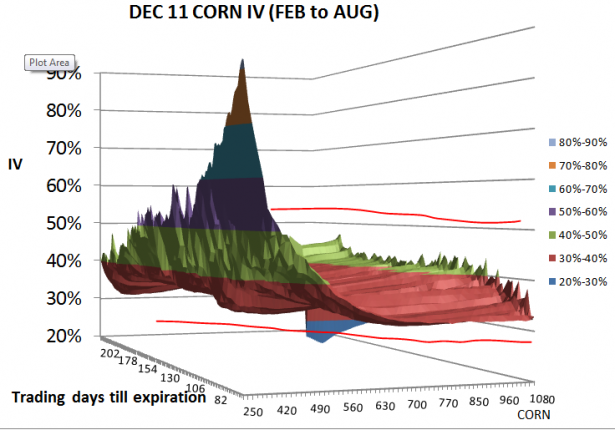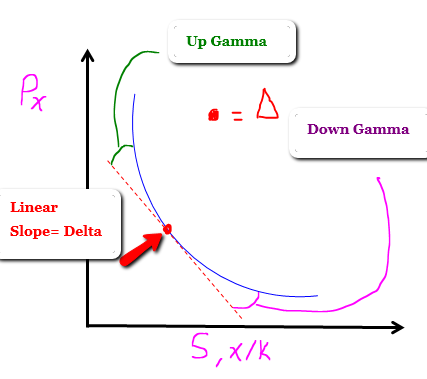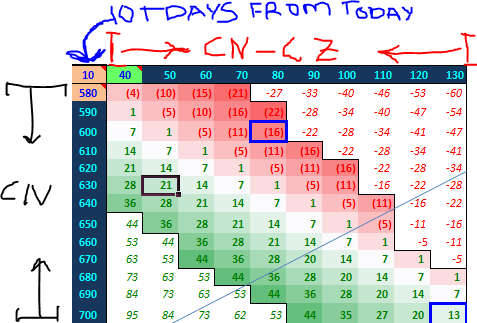Convexity – It’s Evil Too
Convexity – It’s Evil Too
So I (volar) do not have much to say for a market outlook- though the VIX 8 day stat worked out well (with hindsight and inductive reasoning bias).
Banking coin is never easy- but avoiding stupid decisions really makes the difference. Convict keeps it simple- and frankly that is why he is solvent. Solvent traders have a better probability to make coin than the insolvent ones (law of large numbers- just saying). This post is not simple- and will be difficult for a non-options skooled persons, but it should at least give one reason to not stick one’s private parts in a blender (e.g. trading options without the proper tools/knowledge).
I figured this would be one of those informational/discussion threads. THIS IS NOT ACADEMIC- this is real world options trading. Option theory and retail option platforms- yes even TOS- are “cool,” but they will still FUBAR your account.
I am first going to list some caveats for retail platforms and general option trading fallacies- many of which are found in one of my favorite math reads, Dynamic Hedging. Following that, I will discuss them- of course- that means charts from Volar.
Caveat A: SPX options are not the same as corn options.
Caveat B: Option skews, smiles, and decay term structures will rape you.
Caveat C: Not one, not a single greek, can be compared to another greek- even on the same commod on the same contract. This is a function of the “shadow greeks.”
Caveat A:
What do I mean? Well first off each market will have a different smile- smiles affect option valuation paths. Secondly, and most importantly, IV is correlated (inversely) to price in SPX. This is why I have talked about call rape- but its more than that. Also SPX has no “carry” trades or spread trades, consequently, the only spread trading with options in the SPX is VOL time structure (think VIX/VXV). Whereas corn, spread trades do matter…spreads do change, and IV is not inversely correlated to price. Many do not understand that most commodity volume is actually spread volume (eg short JUL, long DEC). If you are playing options in a market where spreads move- you better be careful. A risk reversal calendar spread may have the correct direction, but horrible outcome due to shadow greeks. Even on the SPX, where there is no real spread changes, calender spreads (to capture net short theta, long vega positions), still cause havoc for traders without appropriate tools and experience.
Bottom line for caveat A: you have to have a model for each instrument. If your model does not account for correlations and spread differentials- well you are dead in the water.
Caveat B: Option skews, smiles, and decay term structures will rape you.
This chart is Corn IV over time. Clearly nothing is linear here. Notice that anything less than the 80% IV in the put tail of the first chart is not even readable in the second chart.
This chart is near expiration- yikes.
So my point is that the “VIX” is and “average” but averages the curve. The curve changes options differently. This is the largest reason for novice options traders failing- especially when they use TOS or retail option platforms. Sure your platform may give you a greek number, and even allow you to shift VOL, Time, and Price, but it wont model the IV smile term structure/decay. Toyota has breaks and a gas pedal, but it is not a Ferrari. Even if TOS did model IV term-structure/smile decay- how could you trust it when we know that each commod is different?
Caveat C:
The smile affects option valuations over time. This is where things get hairy- shadow greeks. All retail models use BSM (black scholes merton)- but none account for the curve.
So let’s say one is short a JUL corn call (say 750 handle today). Delta may be -0.10 but that value only holds for today- technically for about 5 minutes. A typical model, presuming no change in price, will make about 3 (priced near 4 today) with 5 days till expiration (45 trading days from today). However, when adjusting for the smile (aka what volar code does), one will lose 3 cents. This is a 6 cent or 100% difference in valuation. Why? real world vs. academics. The IV for tails rises- there is no free lunch. Smiles occur for liquidity and “non- normal” distribution reasons. In any case, nobody holds till expiration, yet they make decisions as if they were holding till expiration. If one do not hold till expiration, one will not get expiration results. Many times OTM options (sold) will make one most of one’s money in 1 day- and waiting till expiration to capture a penny usually ends badly due to bid-ask differentials and IV premiums. Bottom line here- if one’s model does not adjust for reality.. one loses coin.
Now to further talk about how greeks are not comparable… spread trades… again.
Many think front month contracts decay more than back month. Some think the back months have more premium to sell and front months are relatively cheap. Neither is correct or wrong. Both are worthless ” all encompassing” statements- like most CNBC stuff.
A good option model should cover sensitivity to the following:
Here is the dilemma. Is one analyzing 1 day or 1 month? The changes are not linear and they change each other. And each change is multiplied by each other (negative or positive). Yes this looks like crap- but notice that delta is the linear slope of 1 point (chart below). This chart shows that vega moves opposite to decay, and that up gamma is not the same as down gamma. Also a gamma changes on a vol spike or time decay.
Ok so you see delta only matters at (1) a point in time (2) at a particular price (3) given a certain time (4) given a certain IV (Vol)
Now let’s look at an IV spike:
You can see the Curve is less steep, thus the gamma (delta change) is reduced.
Here is a time decay shift:
So… this goes to show that things change. Gamma up is not the same as gamma down. And gamma up for an OTM is utterly different than gamma down. Gamma (delta sensitivity) is inverse to Theta (time decay). The math is 1/2* gamma* (vol)*(Contract price^2). This implies that not ALL front month options, when adjusted for the IV curve structure, will not decay (example above). Secondly, one is exchanging decay risk for price risk.
Consider this with 2 options on two different contracts- each has about 20 moving curves at different rates.
This means one must manage the shadow greeks (bleeds, dvol dtime, ddelta dvol, etc…). Below are the ones I follow on a spread trade. BUT one must adjust this for the IV curve. So when I input the trades I know all of the shadow greeks and I model the IV curve. Also remember the spread may not move 1:1 with front month price….
Below are a list of Greeks and bleeds (or changes to greeks for a list of options). In all reality, scenario analysis encompasses all of this into one value, but one must be able to see what and why things change.
No, retail models do not do this correctly.
I suggest using heat maps for calendar spreads- once one adjusts for the code/IV smile of course. Here is a scenario map for 1 particular point in time. When one starts to analyze options, correctly, they will find that scenario analysis is the most optimal choice.
* test the good, the bad, the ugly. Never test the great. Stay frosty.
The top is the contract spread (JUL- DEC corn), the left is CN (JUL corn).
Here is 2 different vegas (price sensitivity to change in IV) for a JUL , DEC calender corn spread. Notice that front month VEGA declines relative to DEC. This means that those who “think” deferred options carry more “premium” is bull crap. The greeks are less sensitive- even though our above example showed that the IV smile spike/shift offsets the decay.
This means one must learn to trade the greeks and shadow (future) greeks. If one plans out the option scenarios one will find that most “common” ideas from brokerage houses are stupid.
So differed options have less sensitivity, but the gamma is higher and the theta lower.
Another stupid comment I hear is that 90% of option expire worthless. I must say logic like that is pure ignorance. (1) any 400% OTM option may or may not trade, consequently how do you even run stats on an infinite number? Secondly, if margin calls made one bankrupt 30 days before expiration (like MF global, LTCM etal), well expiration did not matter now did it?
Bottom Line: many think they are playing in the kiddy pool when they are actually swimming with a bag of meat on their back offshore Africa in shark infested waters.
Best of luck unbiased trading,
Volar

















